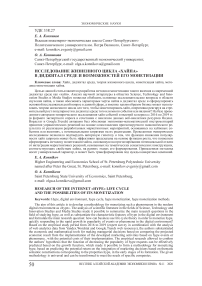Исследование жизненного цикла "хайпа" в диджитал среде и возможностей его монетизации
Автор: Конников Е.А., Конникова О.А.
Журнал: Вестник Алтайской академии экономики и права @vestnik-aael
Рубрика: Экономические науки
Статья в выпуске: 11-1, 2020 года.
Бесплатный доступ
Целью данной статьи является разработка методики монетизации такого явления в современной диджитал среде как «хайп». Анализ научной литературы в областях Science, Technology and Innovation Studies и Media Studies позволил обобщить основные исследовательские вопросы в области изучения хайпа, а также обосновать характерные черты хайпа в диджитал среде и сформулировать основной исследовательский вопрос в данной сфере, а именно: каким образом бизнес может использовать теорию жизненного цикла для того, чтобы монетизировать хайп, оперативно реагируя на стремительный рост популярности в диджитал среде того или много события или явления? На базе проведенного авторами эмпирического исследования хайп событий и явлений за период c 2016 по 2019 гг. (в формате экспертного опроса в сочетании с анализом данных веб-аналитики ресурсов Яндекс.Вордстат и Google.Trends) авторами был обоснован экономико-математический инструментарий принятия управленческих решений на основе сопоставления прогнозируемого экономического результата от реализации разработанных маркетинговых мероприятий, основанных на хайповых событиях или явлениях, с потенциальными затратами на их реализацию. Проведенное эмпирическое исследование позволило подтвердить авторскую гипотезу о том, что функция снижения популярности хайп запросов может быть эффективно предсказана на основе функции роста, что позволило сформировать методику монетизации хайпа, основанную на прогнозировании потенциальной отдачи от интеграции маркетинговых решений, основанных на тематических семантических конструкциях, соответствующих свойствам хайпа, на ранних этапах его формирования. Приведенная методика носит универсальный характер, и может быть трансформирована под нужды конкретных компаний.
Хайп, диджитал среда, теория жизненного цикла, монетизация хайпа, методика монетизации хайпа
Короткий адрес: https://sciup.org/142225072
IDR: 142225072 | УДК: 338.27 | DOI: 10.17513/vaael.1394
Текст научной статьи Исследование жизненного цикла "хайпа" в диджитал среде и возможностей его монетизации
На сегодняшний день слово «хайп» прочно вошло в обиход не только активных пользователей интернета, но и специалистов по контент маркетингу, а также ученых, занимающихся вопросами современных форматов коммуникаций в диджитал среде. Понятие «хайп» (от англ. «hype») появилось в 80-е гг. в США в приблизительном значении «внедрение идеи в сознание индивидов путем целенаправленного разогревания интереса к чему-либо». В России термин «хайп» начал широко распространяться в 2017 году. Экспертный совет при Центре творческого развития русского языка определил десять главных слов 2017 года, отдав термину «хайп» третье место (после слов «реновация» и «биткоин»).
Ассоциации с понятием хайп – «истерия», «шумиха», «ажиотаж», «медиавирус». Точное определение данного термина отсутствует, однако, по мнению авторов, наиболее релевантной коннотацией понятия «хайп» можно считать «внезапный всплеск интереса к какому-либо событию или явлению» [1]. Практически в 100 % случаев событие или явление, которое становится «хайповым», зарождается в цифровой среде, возникая, как правило, вокруг каких-либо активных действий, конфликтов, скандалов [2]. При этом каждое хайповое событие или явление характеризуется отличительной от других продолжительностью периодов нарастания и спада интереса. Изучение хайпа помогает компании количественно измерить интерес публики и принимать на основе этого управленческие решения. Данный тезис подводит нас к такому понятию как «жизненный цикл хайпа» (hype cycle), его изучению и будет посвящена данная статья. Таким образом, цель текущего исследования можно сформулировать следующим образом: разработать методику монетизации «хайпа» в интернет-среде используя теорию жизненного цикла хайпа.
Материал и методы исследования
В научной литературе термин «хайп» возник в области Science, Technology and Innovation Studies в привязке к динамике инновационных процессов [3-5], а конкретно в сфере прогнозирование при- нятия потребителями технологических инноваций [6-7]. Особое внимание уделялось жизненному циклу хайп технологии. В 1995 году компанией Gartner Inc. была создана теория hype cycle (жизненного цикла хайпа), которая является широко используемой эмпирической кривой для описания того, как бизнес-сообщество относится к инновационным идеям и каким образом можно предсказать будущее новой технологии [8]. В научной литературе можно найти множество численных и теоретических моделей, связанных с изучением жизненного цикла хайпа [9-13].
Кривая хайпа в форме колокола в первую очередь основана на внезапной, чрезмерно позитивной и иррациональной реакции на внедрение новой технологии. Существует мнение, что за форму кривой отвечают три феномена человеческой природы: тяга к новизне, социальная «заразность» и эвристическое отношение к принятию решений [14].
Современные ученые занимаются изучением базовых состояний жизненного цикла хайпа, а также изменения формы кривой хайпа в зависимости от существующего контекста [9], например, в различных отраслях [35-36], а также отдельно со стороны производителя и потребителя [15]. При этом для исследования используется совокупность экспертных методов и методов контент-анализа [15-17]. Большая часть подобных исследований сконцентрированы в предметной области менеджмента и информационных (мобильных) технологий [8, 18]. Некоторые авторы даже используют теорию жизненного цикла хайпа для описания интереса академического сообщества к технологическим инновациям и прогнозирования количества научных публикаций по определенным тематикам [19].
С развитием диджитал технологий данные исследования были позаимствованы Media Studies для измерения вероятности успеха и продолжительности популярности какого-либо события в интернет-среде [20-24]. При этом ученые задаются следующими вопросами:
– Почему какие-то явления становятся хайповыми в медиа-среде, а какие-то нет? Какие субъекты вовлечены в эти процессы? [25] Ряд специ- алистов утверждают: чтобы стать хай-повым, некое событие должно отвечать общим новостным ценностям, но также должно содержать некоторое нарушение общепринятых социальных норм, быть пригодным для публичных дебатов и, наконец, его должно быть возможно осветить с разных точек зрения [26];
– Какова структура и динамика хай-па? Как долго он длится, какой силы может достичь, по какой траектории распространяется? В том же источнике [26] утверждается, что хайп по какому-либо поводу в интернет-среде начинается с некоего названного «триггерным» события, длится примерно три недели и происходит в несколько, обычно три, волны уменьшающейся интенсивности;
– Какие факторы стимулируют развитие хайпа? Относятся ли они более к эндогенной или экзогенной управляемой активности? [27, 28].
По результатам авторского анализа, хайпу как явлению присущи следующие характеристики [2]:
-
1. Скорость распространения , выраженная в степенной зависимости между количеством запросов в основных поисковых системах и временем . Данная характеристика исходит из того, что «хайповая» новость отличается от обычной «ажиотажной» определённой рекурсивностью. Информационный фон (ноосфера) становится настолько насыщен информацией относительно изучаемого явления, что поводом изучения становится сам факт перенасыщения. Проверить данный факт можно аппроксимировав временные ряды запросов степенной функцией, что будет выполнено далее в рамках данной статьи;
-
2. Короткий жизненный цикл хайп-проектов без выраженной стадии «зрелость» . Жизненный цикл хайпового явления включает в себя стадии зарождения, роста и спада, таким образом, фаза зрелости фактически отсутствует: интерес пользователей быстро переключается на что-то новое [29]. Например, если анализировать всплески популярности пользовательских запросов «спиннер» и «Pokemon Go» согласно ресурсу Яндекс.Вордстат, то их жизненный цикл составляет 3 и 4 месяца соответственно и имеет форму пика с резкими подъемом и спадом;
-
3. Широта охвата или освящение исследуемого явления в непрофильных СМИ . В данном случае под «непрофильными» можно понимать как непрофильные информационные ресурсы единого типа с материнским ресурсом (например, освещение на непрофильных интернет порталах), так и непрофильные информационные ресурсы не единообразного типа (например, освещение на радио, телевидении и т.д.). Например, рэп-баттл Oxxxymiron vs Dizaster, в одночасье получившей статус «хайпового» в диджитал среде, широко освещался даже по абсолютно «непрофильному» Первому Каналу.
Многие исследования показывают, что помимо взаимодействия в социальных сетях, освещение события в «традиционных» новостных СМИ является важным фактором, которое вызывает максимальную величину хайпа в социальных сетях. [30-32] И наоборот, социальные сети также могут влиять на новостное наполнение традиционных медиа-ресурсов [33]. Безусловно по мере того, как медиа-платформы становятся все более взаимосвязанными, становится необходимым учитывать последствия взаимодействия между различными социальными сетями и типами медиа [31].
Попытка использовать хайповые события в бизнесе видится насколько привлекательной и прибыльной, настолько и рискованной. Это потенциально опасная тактика, поскольку за острым пиком энтузиазма публики к какой-либо теме часто следует резкий период спада [34]. Согласно «классической» теории жизненного цикла хайпа, он последовательно проходит следующие стадии: резкий взлет, пик, падение, стабилизация и плато [14]. Таким образом, основной исследовательский вопрос в рамках данной статьи можно сформулировать следующим образом: каким образом бизнес может использовать теорию жизненного цикла для того, чтобы монетизировать хайп, оперативно реагируя на стремительный рост популярности в интернет-среде того или много события или явления?
В соответствии с целью данного исследования может быть сформирована укрупненная теоретическая методика монетизации хайпа в интернет среде, состоящая из следующих этапов [37]:
-
1. Выявление тематических семантических конструкций, соответствующих приведенным ранее свойствам хайпа, на ранних этапах формирования;
-
2. Разработка маркетинговых решений, основанных на выявленных тематических семантических конструкциях;
-
3. Прогноз экономического результата реализации разработанных маркетинговых решений;
-
4. Принятие управленческого решения относительно целесообразности реализации разработанных маркетинговых решений.
Проработка инструментария для целей реализации каждого из выделенных этапов может являться предметом отдельных исследований. Однако этап 2 в меньшей степени универсализируем, так как обозначенные маркетинговые решения не могут быть обозначены вне привязки к конкретному товару, потребителю или рынку, а также сам процесс разработки носит во многом творческий характер.
Этап 1 связан с процессом автоматизированной обработки естественного текста и/или эвристической обработки информации в интернет-медиа и социальных сетях. В рамках текущего авторского исследования выбор тематических семантических конструкций, соответствующих свойствам хайпа, осуществлялся экспертно. В качестве экспертов выступили 6 активных пользователей российского сегмента интернета (3 мужчины и 3 женщины, средний возраст – 29 лет). Экспертам было необходимо предложить по 20 семантических конструкций, соответствующих свойствам хайпа, и обозначить условный ретроспективный период времени их реализации. Повторяющиеся как минимум 3 раза конструкции составили итоговую выборку:
-
1) «Reebok» (04.02.2019 – 12.02.2019);
-
2) «Хабиб Нурмагомедов» (03.10.2018 – 11.10.2018);
-
3) «Оксимирон Гнойный» (10.08.2017 – 18.08.2017);
-
4) «Шурыгина» (17.02.2017 – 25.02.2017);
-
5) «Пенсионная реформа» (17.02.2017 – 25.02.2017);
-
6) «Петросян развод» (08.07.2018 – 16.07.2018);
-
7) «Идов» (22.02.2019 – 02.03.2019);
-
8) «Соболев» (03.03.2017 –
11.03.2017);
-
9) «Tramp» (05.11.2016 – 13.11.2016) (Данная семантическая конструкция (поисковый запрос) намеренно анализировалась в неправильном написании);
-
10) «Он вам не Димон» (22.03.2017 – 30.03.2017);
-
11) «Дружко» (27.04.2017 –
05.05.2017);
-
12) «Децл» (30.01.2019 – 07.02.2019);
-
13) «Dizaster» (12.10.2017 – 20.10.2017);
-
14) «Руки базуки» (06.12.2017 – 14.12.2017);
-
15) «Hype camp» (21.09.2017 – 29.09.2017);
-
16) «Хованский Ларин» (17.03.2016 – 25.03.2016);
-
17) «Гуф Птаха» (15.02.2018 – 23.02.2018);
-
18) «Эрик Давидович» (18.02.2016 – 26.02.2016).
Единицами изменения уровня хайпа в данном случае выступают проценты доли запросов относительно локального максимума (p), так как именно данные единицы измерения используются системой Google Trends. Период определен эмпирически, и составляет 9 дней с максимальным значением в 100 % на 5-й день. В соответствии с описанными ранее свойствами хайпа и на основе анализа статистики поисковых запросов в системе Google Trends определены локальные максимумы. Пример представлен на рис. 1.
Как можно видеть на нижнем графике, за период в 3,5 года отдельно можно выделить пик, приходящийся на осень 2018 года. На верхнем графике приведено масштабирование данного периода. Структура временного ряда характеризуется 2 ярко выраженными стадиями: экспоненциальный рост и резкое степенное падение. При этом пик является окончанием первой стадии и началом второй.
В рамках этапа 4 предложенной ранее методики монетизации хайпа в интернет среде предлагается использовать одномерный критерий принятия управленского решения: в том случае если прогнозируемый экономический результат от реализации разработанных маркетинговых мероприятий (Rsum) превышает потенциальные затраты (Z), принимается решение о реализации данных мероприятий. В случае обратного эффекта данные мероприятия отвергаются. Калькуляция Z также носит не универсальный характер и в значительной мере дифференцируется в зависимости от предприятия [38]. При этом оценке Rsum полностью посвящен этап 3 сформированной укрупненной методики.
Оценка Rsum может быть универсализирована на основе анализа закономерностей развития хайпа в сети интернет. На приведенном выше графике отчетливо видно, что жизненный цикл хайпа может быть условно разделен на 2 этапа: стремительный рост популярности хайп-запроса и его стремительное падение. Следовательно, данный жизненный цикл может быть описан 2 функциями (роста популярности хайп-запроса и снижения популярности хайп-запроса):
f (ap„; bn; n ) = pnc f (apdec;bdec; m) = pmc, где pninc – доля исследуемых поисковых запросов в системе Google Trends относительно локального максимума исследуемых поисковых запросов в рамках этапа стремительного роста ( %);
pm dec – доля исследуемых поисковых запросов в системе Google Trends относительно локального максимума исследуемых поисковых запросов в рамках этапа стремительного снижения ( %); ap inc и ap dec – константы;
b inc и b dec – коэффициенты регрессии;
n – номер соответствующего периода в рамках этапа стремительного роста (в данном исследовании n [1 - 5]);
n – номер соответствующего периода, в рамках этапа стремительного снижения (в данном исследовании m [1 – 5]).
В рамках данного исследования выдвигается гипотеза о том, что функция снижения популярности хайп-запроса может быть определена на основе функции роста его популярности. Следовательно, эндогенной переменной выступает соответствующий коэффициент регрессии (b dec ). Константа ap dec может быть универсализирова-н p а и определена как условно-среднее значение. Экзогенными переменными в данном случае выступают соответствующий коэффициент регрессии (b inc ), соответствующая константа (ap inc ) и соответствующий коэффициент детерминации (Rinc 2 ). Показателями качества модели в данном случае выступают нормированный R 2 , p-значение переменных модели, а также эвристическая оценка распределения остатков и выбросов.
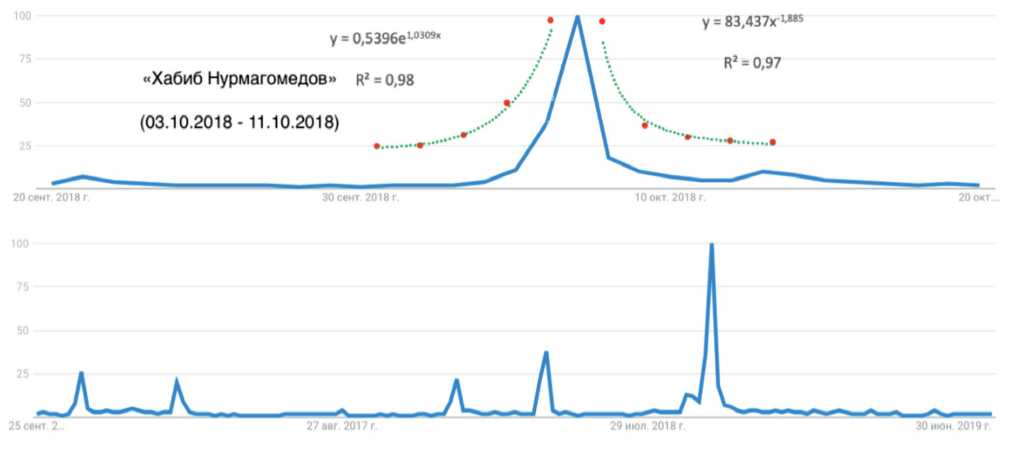
Рис. 1. Примеры статистики поискового запроса «Хабиб Нурмагомедов» (в системе Google Trends)
Фаза снижения популярности хайп-запроса
Фаза роста популярности хайп-запроса
1,8535 е0-7758х
R2 = 0,8879
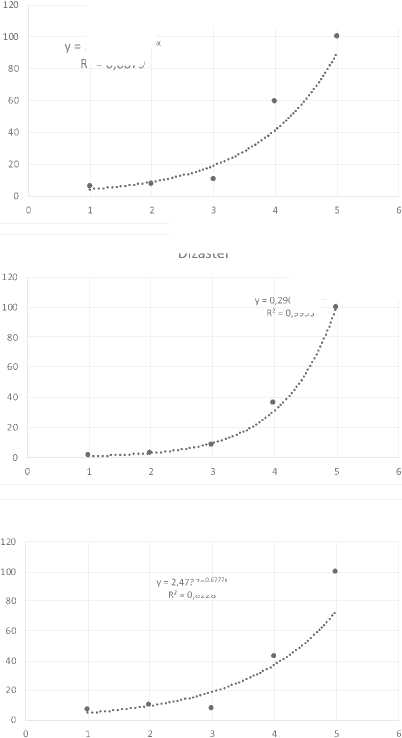
= 2,4737еУЛ///>!
у = 101,38х"0,757
R2 = 0,9933
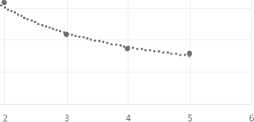
Dizaster
Ю8е1,1695х
Dizaster
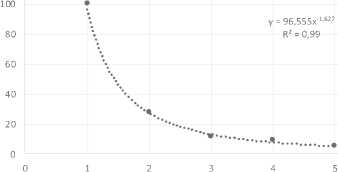
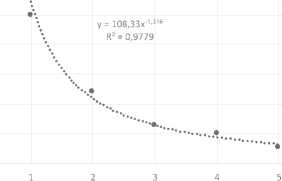
Рис. 2. Примеры функционального описания поисковых запросов
Результаты исследования и их обсуждение
Исследуемая статистика бралась в рамках дневных интервалов. Безусловно, часовое или минутное распределение было бы более релевантным для целей данного исследования, однако это бы требовало введения дополнительных переменных, которые могли бы значительно усложнить проводимый эксперимент и внести неточности в получаемые результаты. Для каждой из избранных семантических конструкций было сформировано 2 выборки, описывающие период роста и период снижения популярности хайп-запроса. При этом момент завершения периода роста является началом периода снижения. Каждый из 36 полу- ченных временных рядов описан функцией, имеющей наибольший коэффициент детерминации. На рис. 2 приведено 3 наиболее значимых примера.
Наиболее эффективно фаза роста популярности хайп-запроса описывается экспоненциальной функцией в 100 % случаев, в то время как фаза снижения популярности хайп-запроса также в 100 % случаев наиболее эффективно описывается степенной функцией. Среднее значение коэффициента детерминации для функций, описывающих фазу роста, составляет 0.77 и не опускается ниже 0.55, что указывает на достаточное качество аппроксимации. Для фазы снижения среднее значение данного показателя составляет 0.93, а минимальное –
0.71, что указывает на высокое качество аппроксимации. Полученные данные имеют достаточное качество для тестирования приведенной ранее концептуальной модели.
Результатом проведённого анализа стала следующая модель множественной регрессии:
bdec = - 0.72 - 1.45* b n + 0.79* R^ c . (2)
В связи с недопустимым p-значением переменной ap inc она была исключена. Коэффициент детерминации данной модели составляет 0.78, что указывает на ее высокое качество. Следовательно, эндогенная переменная находится в обратной зависимости от коэффициента регрессии функции роста и в прямой зависимости от коэффициента детерминации функции роста, что не противоречит формальной логике. На рис. 3 представлено сравнение фактических и предсказанных значений, а также верхняя и нижняя границы доверительного интервала.
Как можно видеть, на рис. 3 отсутствуют значимые структурные выбросы, что также указывает на высокое качество модели. Следовательно, подтверждается авторская гипотеза о том, что функция снижения популярности хайп зпросов может быть эффективно предсказана на основе функции роста.
Как отмечалось ранее, параметр apdec может быть задан дискретно. В соответствии с проведенным анализом, было установлено, что среднее значение данного показателя составляет 99.18 при среднем отклонении в 5.7 %. Так как данное отклонение является условно допустимым, полученное значение принимается в качестве универсального. Таким образом, функция снижения популярности хайп-запроса примет следующий вид:
pmc = 99.18* m - °- 72 - 1 - 45 * b + °- 79 * R 2c . (3)
Посредством данного уравнения может быть спрогнозировано снижение популярности хайп-запроса в сети интернет. Однако данная прогностическая величина не имеет прикладной значимости вне привязки к экономическим категориям. Следовательно, необходимо разработать модель конвертации данной величины в описанную ранее величину прогнозируемого экономического результата от реализации разработанных маркетинговых решений (Rsum).
Как описывалось ранее, драйвером монетизации хайпа является приращение трафика, приходящегося на соответствующие интернет ресурсы компании, использующей хайп события при разработке маркетинговых решений. Интеграция в инструменты продвижения тематических семантических конструкций, соответствующих приведенным свойствам хайпа, на ранних этапах формирования позволит прирастить данный трафик. Таким образом, для оценки Rsum необходимо сформировать инструменты оценки потенциальной конверсии дополнительного трафика, а также конверсии оцениваемой pm dec в данный трафик.
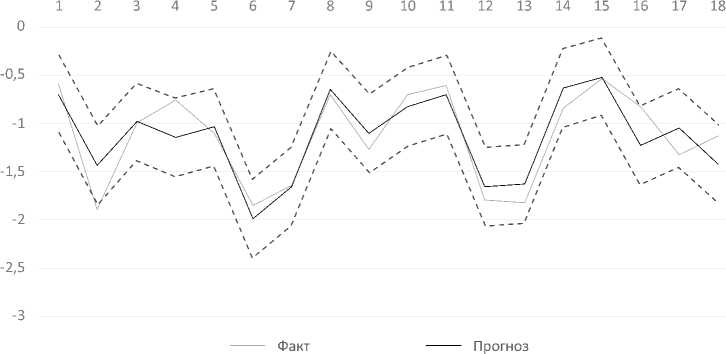
Рис. 3. Соотношение фактических и предсказанных значений bdec
Для целей оценки конверсии прогнозируемой суммарной pm dec в дополнительный трафик предлагается ввести условный коэффициент конверсии хайпа (k1 conv ), отражающий прирост посещений интернет ресурса копании за счет интеграции маркетинговых решений, основанных на выявленных «хайповых» семантических конструкциях. Данный коэффициент может быть определен экспертно или статистически. Базой для применения данного коэффициента может быть номинальное усредненное число посетителей интернет ресурса копании за исследуемый период времени (G nom ). Данный показатель может быть определен исключительно статистически, и он индивидуален для каждой отдельной компании. Таким образом, модель расчёта прироста потенциального трафика за прогнозируемый период времени (Gm) примет следующий вид:
m
G m _ к Г * 5 - * £ рт« . (4)
Таким образом, решение относительно целесообразности реализации разработанных маркетинговых мероприятий может приниматься на основе истинности следующего неравенства:
Z < kconv * Rnom * kconv * Giom *
m
* ^ 99.18
* m -0.72 - 1.45* blnc + 0.79* R hc
Следующим этапом является оценка экономического результата от реализации разработанных маркетинговых решений на основе прогнозируемого прироста потенциального трафика. Для данных целей предлагается ввести дополнительный коэффициент конверсии (k2 conv ), отражающий долю актов приобретения товара или услуги по результатам посещения интернет ресурса компании. [3940] Природа данного коэффициента схожа с природой k1 conv , и он также не может быть универсально определен. Базой для его применения может являться средняя номинальная цена заказа (R nom ). Расчет Rsum примет следующий вид:
R
sum
_ k conv * Rhom * G
В случае истинности данного неравенства реализация разработанных маркетинговых решений является целесообразной.
Заключение
В рамках данной статьи рассматривался феномен хайпа в интернет среде и возможная методология его монетизации. Анализ мирового опыта позволил определить основные свойства хайпа. По результатам эмпирического исследования предложена методика монетизации хайпа, основанная на прогнозировании потенциальной отдачи от интеграции маркетинговых решений, основанных на тематических семантических конструкциях, соответствующих свойствам хайпа, на ранних этапах его формирования. Приведенная методика носит универсальный характер, и может быть трансформирована под нужды конкретных компаний. В рамках дальнейших исследований авторы намерены разработать инструментарий для определения предложенных коэффициентов конверсии k1 conv и k2 conv , эмпирически исследовать эффективность предложенного в рамках данной статьи прогностического инструментария, а также исследовать развитие выделенных свойств хайпа и предложить универсальный классификатор хайп-явлений.
Список литературы Исследование жизненного цикла "хайпа" в диджитал среде и возможностей его монетизации
- Рашкофф Д. Медиавирус! Как поп-культура тайно воздействует на ваше сознание. М.: Ультра. Культура, 2003. 368 с.
- Конников Е.А., Конникова О.А. Тренды коммуникационного пространства в цифровой среде: феномен "хайпа". Вторая международная конференция "Управление бизнесом в цифровой экономике": сборник тезисов выступлений, 21-22 марта 2019 года, Санкт-Петербург / Под общей ред. д.э.н., профессора Аренкова И.А. и к.э.н., доцента Ценжарик М.К. СПб.: ИПЦ СПбГУПТД, 2019. С. 164-166.
- Phillips F., 2001. Market-oriented Technology Management: Innovating for Profit in Entrepreneurial Times. Springer Verlag.
- Ortt J.R., Schoormans J.P.L. The pattern of development and diffusion of break- through communication technologies. European Journal of Innovation Management. 2004. 7 (4). Р. 292-302.
- Routley M., Phaal R., Probert D. Exploring industry dynamics and interactions. Technological Forecasting & Social Change. 2013. 80 (6). Р. 1147-1161.
- Windand J., Mahajan V. Marketing Hype: A New Perspective for New Product Research and Introduction. Journal of Product Innovation Management 1987:4:43-49.
- Rogers, E.M., 1962. Diffusion of Innovations. Free Press, Glencoe.
- Fenn J., (Gartner Group, Stamford, CT, 1995) Fenn, J., Rasinko, M., 2011. Understanding Gartner's Hype Cycles. Gartner Inc. (G00214001 http://www.gartner.com/ technology/research/methodologies/hype-cycle.jsp)
- Van Lente H., Spitters C., Peine A. Comparing technological hype cycles: Towards a theory. Technological Forecasting & Social Change 80 (2013). 1615-1628.
- Yeon S.-J., Park S.-h., Kim S.-W. 2006. A dynamic diffusion model for managing customer's expectation and satisfaction. Technological Forecasting & Social Change 73, 648-665.
- Verhulst P.F. 1845. Nouveaux Mémoires de l'Académie Royale Des Sciences et Belles-Lettres de Bruxelles. 18 p. 1.
- Bettencourt L.M.A., Kaiser D.I., Kaur J., Castillo-Chavez C., Wojick D.E. 2008. Population modelling of the emergence and development of scientific fields. Scientometrics 75, 495-518.
- Campani M., Vaglio R. 2015. A simple interpretation of the growth of scientific / technological research impact leading to hype-type evolution curves. Scientometrics 103, 75-83.
- Fenn J., Raskino M., 2008. Mastering the Hype Cycle: How to Choose the Right Innovation at the Right Time. Harvard Business School Press.
- Jun S.-P. A comparative study of hype cycles among actors within the socio-technical system: With a focus on the case study of hybrid cars. Technological Forecasting & Social Change 79 (2012) 1413-1430.
- Konrad K. The social dynamics of expectations: the interaction of collective and actor-specific expectations on electronic commerce and interactive television. Technology Analysis and Strategic Management. 2006. 18 (3/4). Р. 429-444.
- Alkemade F., Suurs R.A.A. Patterns of expectations for emerging sustainable technologies. Technological Forecasting & Social Change. 2012. 79. Р. 448-486.
- Lavine M. 2010. What would A. G. Bell say now? Science 329, 1470-1471.
- Silvestrini P., Amato U., Vettoliere A., Silvestrini S., Ruggiero B. Rate equation leading to hype-type evolution curves: A mathematical approach in view of analysing technology development. Technological Forecasting & Social Change 116 (2017) 1-12.
- Bataev A.V. Analysis and development the digital economy in the world. Proceedings of the 31st International Business Information Management Association Conference. 2018. P. 61-71.
- Bataev A.V., Gorovoy A.A., Mottaeva A. Evaluation of the future development of the digital economy in Russia. 2018. Proceedings of the 32nd International Business Information Management Association Conference. P. 88-101.
- Nikolova L.V., Rodionov D.G., Litvinenko А.N. Sustainability of the business in the conditions of globalization. 2017. Proceedings of the 30th International Business Information Management Association Conference. P. 417-421.
- Galimova M., Gileva T., Mukhanova N., Krasnuk L. Selecting the path of the digital transformation of business-models for industrial enterprises. 2019. IOP Conference Series: Materials Science and Engineering. 497. 1.
- Zhilenkova E., Budanova M., Bulkhov N., Rodionov, D. Reproduction of intellectual capital in innovative-digital economy environment. 2019. IOP Conference Series: Materials Science and Engineering. 497. 1.
- Entman R.M., 2003. Cascading activation: contesting the White House's Frame after 9/ 11. Polit. Commun. 20, 415-432.
- Wien C., Elmelund-Præstekær C. An Anatomy of Media Hypes: Developing a Model for the Dynamics and Structure of Intense Media Coverage of Single Issues. European Journal of Communication. Volume: 24 issue: 2, page(s): 183-201.
- Lehmann J., Gonçalves B., Ramasco J. 2012. Dynamical classes of collective attention in twitter. Proc. 21st.
- Oka M., Hashimoto Y., Ikegami T., 2014. Self-organization on social media: endo-exo bursts and baseline fluctuations. PLoS One 9, e109293. 10.1371/ journal.pone.0109293.
- DOI: 10.1371/journal.pone.0109293
- Ефанов А.А. "Хайпы" в современном поле медиа // Знак: проблемное поле медиаобразования. 2018. № 1 (27). С. 63-69.
- Bandari R., Asur S., Huberman B.A. 2012. The Pulse of News in Social Media: Forecasting Popularity. In: Proceedings of the Sixth International Conference on Weblogs and Social Media - ICWSM '12.
- Kim M., Newth D., Christen P. 2013. Modeling dynamics of diffusion across heterogeneous social networks: news diffusion in social media. Entropy 15, 4215-4242.
- DOI: 10.3390/e15104215
- Yang J., Leskovec J. 2010. Modeling information diffusion in implicit networks. In: Proc. - IEEE Int. Conf. Data Mining, ICDM. Р. 599-608.
- DOI: 10.1109/ICDM.2010.22
- Hellsten I., Vasileiadou E. 2015. The creation of the climategate hype in blogs and newspapers: mixed methods approach. Internet Res.
- Dedehayir O., Steinert M., The hype cycle model: A review and future directions, Technological Forecasting & Social Change (2016).
- DOI: 10.1016/j.techfore.2016.04.005
- Панин В.С. Анализ отзывов в сети Интернет как метод оценки потребительской удовлетворенности для российских банков // Маркетинг и маркетинговые исследования. 2018. № 1. С. 20-30.
- Головачева К.С., Смирнова М.М. Маркетинговое воздействие на потребителей в экономике знаний // Маркетинг и маркетинговые исследования. 2018. № 4. С. 272-282.
- Konnikov E., Konnikova O. Methodology of Hype Monetization in the Internet Environment According to the Life Cycle Theory. SPBPU IDE ‘19: Proceedings of the 2019 International SPBPU Scientific Conference on Innovations in Digital Economy October 2019 Article No.: 28. P. 1-6.
- Lebedev O.T., Mokeeva T.V., Rodionov D.G. Matrix structures of science and technology innovations development and implementation trajectory. 2018. Proceedings of the 31st International Business Information Management Association Conference. P. 1759-1768.
- Demidenko D.S., Kulibanova V.V., Maruta V.G. Using the principles of "digital economy" in assessing the company's capitalization. 2018. Proceedings of the 31st International Business Information Management Association Conference. P. 6087-6091.
- Kuladzhi T., Babkin I., Murtazayev S.-A., Golovina T. Digital matrix micro forecast of informational and telecommunicational products cost value. 2017. Proceedings of the 2017 International Conference "Quality Management, Transport and Information Security, Information Technologies", IT and QM and IS 2017. P. 233-239.

